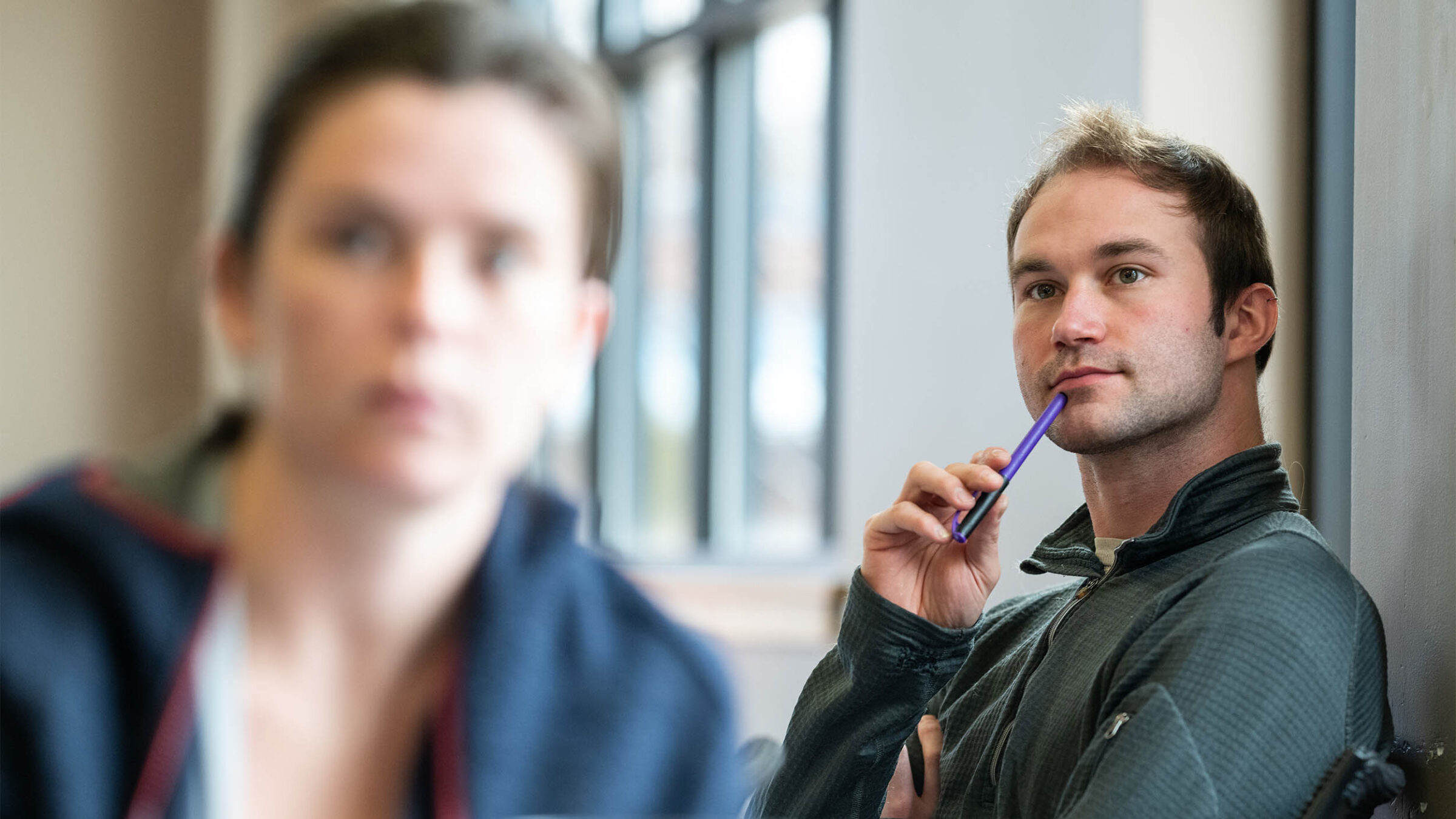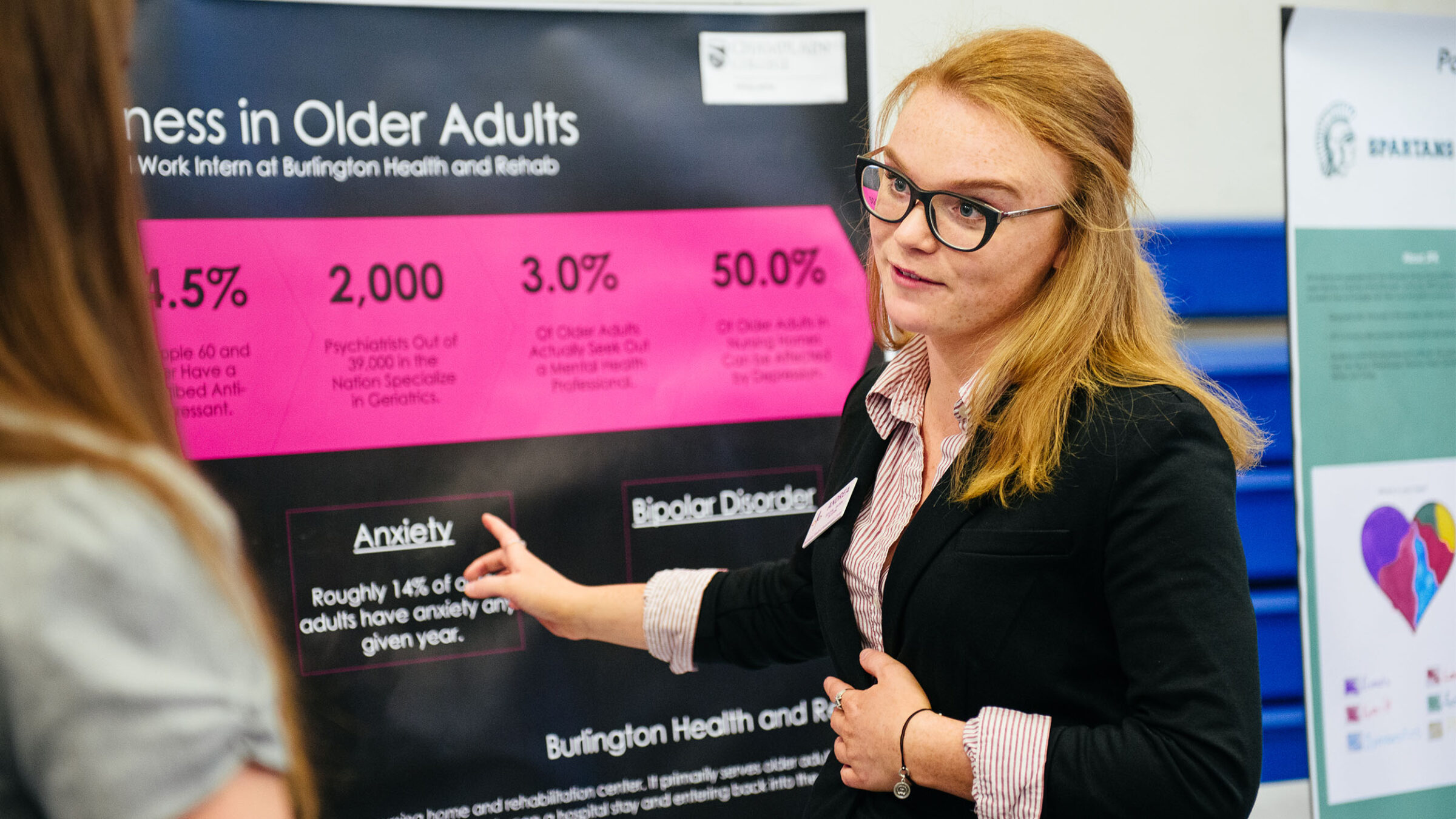Psychology Major
Study human motivations in a career-focused Psychology major that prepares you for this dynamic field.

Learn the why behind our thoughts and actions.
Study human behavior, explore the latest theories and applications, and build a solid theoretical, empirical and practical foundation for your future career through the versatile Psychology program at Champlain.
What Is Psychology?
Psychological studies provide a fascinating lens for seeing and understanding the world around you. Psychologists look to explore and explain how people think, feel, and behave. If you’ve wondered about things like why world leaders make the decisions they do, how and why weather affects our moods, or how happiness happens in the brain, we invite you to investigate answers with us at Champlain.
Why Study it at Champlain?
Like all of Champlain’s academic programs, Psychology is grounded in hands-on learning that puts you at the center of your studies. You’ll have the support of faculty and career counselors to explore the field and uncover your calling. The curriculum includes two internships throughout your time at Champlain—one during your second year and the other during your fourth year—to expand learning beyond the classroom and build professional experience. All for academic credit.
Recognizing the breadth and depth of the psychology field, the program includes your choice from one of three concentrations to begin narrowing your area of study by your third year. They are:
- Health & Wellbeing: Learn more about the skills and the different approaches that a psychologist can use to promote and support personal wellbeing—exploring different approaches to counseling, music therapy, expressive writing, etc.
- Social Change/Social Impact: Learn how to build, evaluate, and apply different types of interventions, targeting specific societal problems and using the science of psychology to impact change
- Flex Path: Work closely with a Psychology faculty member to specifically customize your degree focus to your personal desires. You will receive tailored support to design your ideal curriculum with the intent of maximizing your résumé to fit with your long-term goals.

Different by Design
Get Professional Experience
This professionally focused program requires two internships before you graduate, giving you real-world experience before your career even starts.
Built-In Career Support
Early in your studies, faculty integrate Career Collaborative services into the classroom to build both your professional experience and confidence.
Find Your Calling, Focus Your Studies
Explore any of three concentrations to ground your psychological studies in the area you’re most drawn to.
Facts & Stats
of Psychology graduates in the Class of 2023 achieved career success within six months after graduation. That’s success you can see.
The annual median salary of psychologists in 2023, according to the U.S. Bureau of Labor Statistics.
Percent of Champlain’s Psychology graduates over the past six years have been either employed or continuing their education within six months after graduating.
Sign Up for Helpful Info
Sample Courses in the Psychology Major
Our Psychology curriculum is designed to give you a foundation for understanding of the human mind, behavior, and the scientific study of psychology. From there, you’ll dive into specific topics and have the ability to tailor your learning to focus on the specific areas and applications of psychological science you’re passionate about. Check out some of the engaging and hands-on courses in our program.
Concentrations
-
Flex Path Psychology Concentration
Tailor your Psychology degree with a Flex Path concentration and explore applications of psychology to the field of your choice at Champlain College.
-
Health & Wellbeing Concentration
Tailor your Psychology degree with a Health & Wellbeing concentration and explore the impact of biological, social, and physical factors at Champlain College.
-
Social Change / Social Impact Concentration
Tailor your Psychology degree with a Social Change/Social Impact concentration and explore the intersections of culture and social justice at Champlain College.
You might also be interested in these…
Based on your interest in the Psychology major, we thought you also might like to check out these other academic programs and opportunities.
-
Majors
-
Digital Humanities Major
Be a digital pioneer. Bring the fullness of your human self to the study of emerging technology, including Artificial Intelligence, and make sure the digital future is humane as well as human.
-
Criminology & Criminal Justice Major
Make communities safer. Build a better and more just system. Be an agent of organizational change.
-
Education Major
Teaching is the ultimate way to shape the future. At Champlain College, you’ll be in classrooms during your first year, building deep expertise that leads to licensure.
-
Social Work Major
Uplift families, empower individuals, and heal communities with Champlain’s Social Work major.
-
Integrative Professional Studies Major
Design your own major through Champlain’s Degree Design Lab. You’ll combine courses and real-world learning experiences to personalize your own education.
-
-
Minors
-
Conflict Management Minor
Develop a practical way of mediating conflict in your workplace, community, and personal life with Champlain College’s Conflict Management Minor.
-
Family Studies Minor
Explore concepts of the individual, family, and community. Further develop your understanding as you discover the connections between them within historical, political, and social climates.
-
Gerontology Minor
Examine the physical, mental, and sociological aspects of aging, including the ways that society changes with an aging population with the Gerontology minor.
-
LGBTQ Studies Minor
Examine the complex histories, cultures, political activities, and expressions of LGBTQ people while exploring larger social and institutional foundations like media representation and human rights.
-
-
Areas of Study
-
Individualized Studies & Undeclared
Learn what you love, and love what you learn with one of these professional pathways.
-
Education, Humanities & the Sciences
The born educator, the team player, the change maker, the advocate. Which of these human-centered majors fits you career goals?
-
Law & Society
Want to uphold a system of justice through meaningful public service? Check out these majors that revolve around “doing good.”
-
Career Success
Our Psychology students graduate with valuable professional experiences and a breadth of knowledge. 100% of Psychology majors in the Class of 2023 achieved career success.

Your Career Outlook
By the time you graduate, you will …
- Justify your own and evaluate others’ actions using the general ethical principles of the American Psychological Association as a framework.
- Apply major psychological concepts, theoretical perspectives, and empirical findings to personal, social, organizational, and professional issues.
- Use a historically informed and culturally sensitive perspective when applying psychology to personal and professional situations.
- Design, conduct, analyze, and interpret basic and applied psychology research.
You’ll Find a Career In…
- Clinical psychology
- Addiction & intervention strategies
- Marketing & advertising
- Product design & development
- Child psychology & family counseling
- Neuroscience research
- Law enforcement & criminal justice
More Inside Psychology Major
-
Overview
Study human motivations in a career-focused Psychology major that prepares you for this dynamic field.
-
Curriculum
Your career in psychology begins now with Champlain’s Upside-Down Curriculum. Discover the difference that doing on day one has on your success.
-
Faculty
Learn more about the experienced professionals leading Champlain College's psychology program who are dedicated to teaching and mentoring you.
